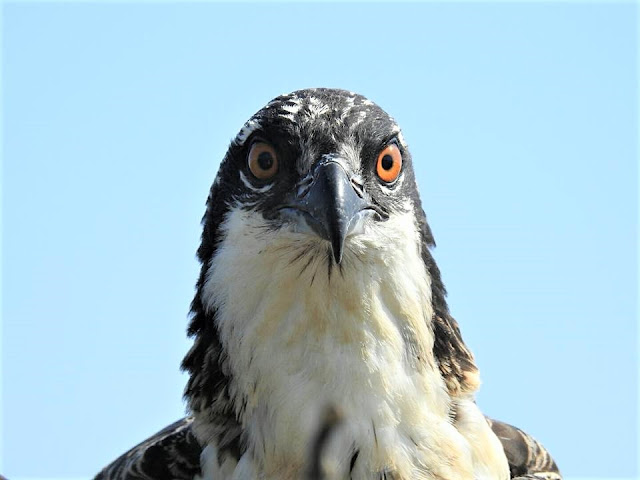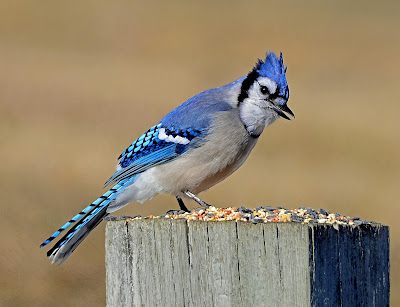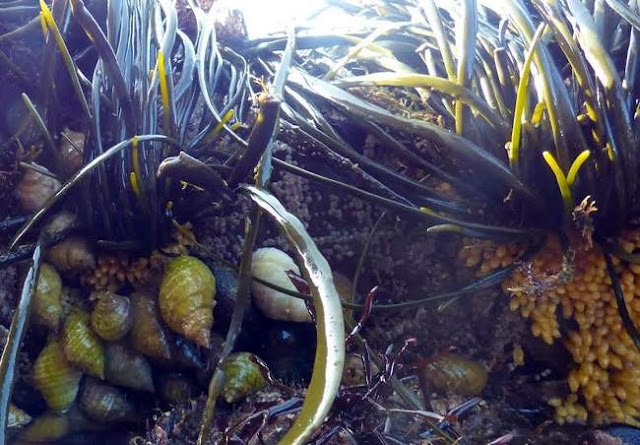Osprey
by Sue Pike August 7 2017 http://www.seacoastonline.com/news/20170808/ospreys-continue-to-rebound-and-do-well
My first thought upon approaching the nesting platform was whether I should be worried about the angry parent ospreys circling over our heads and shrieking at us. I was accompanying the Essex County Greenbelt’s Director of Land Stewardship, David Rimmer, as he visited osprey nesting platforms along the Merrimac River. No one else in the boat seemed alarmed by the aggressive antics of these beautiful (but somewhat scary up-close) raptors so I decided not to worry.
Osprey are something of a success story. In the early 1950s their population crashed as the use of pesticides (DDT in particular) became widespread. Along the New England coast over 90 percent of breeding pairs disappeared. After the 1972 DDT ban, populations rebounded and numbers have been building ever since.
Back in 2007 Dave saw the need for nesting platforms for the local osprey — tree removal and coastal development had reduced available nesting sites and structures being used were often unsafe — so, he started building and installing platforms. Aside from building nesting platforms, Dave bands young osprey when they are almost fully fledged — just before they are old enough to fly. Banding birds helps researchers better understand how and where to direct conservation efforts. Essex County Greenbelt has also collaborated with a leading osprey researcher, Rob Bierragaard, to study osprey migration using solar-powered transmitters that sit on the osprey’s back rather like a little backpack. These transmitters allow more precise tracking of osprey movements than banding does. This is important. Osprey migrate to Central and South America during the winter. Because of satellite tracking, we are now getting a better idea of where exactly osprey winter, what resources they utilize along the way, and how best to direct conservation efforts.
These transmitters also connect individual birds with an admiring audience. Everyone I talked to in the Greenbelt group knew the local birds by name and followed their movements with interest. Flow, for example, was fitted with a transmitter in 2013 and migrated as a juvenile down to Cuba and stayed until the spring of 2016. He’s been back the last two summers but hasn’t settled down yet. Last I checked (you can see a map of Flow’s movements on the Greenbelts’ osprey research website at www.ecga.org) Flow was hanging out in Kittery and along the New Hampshire coast. Everyone was interested in what he would do next — was he nesting up in Kittery? Would he ever settle down?
 |
| Banding osprey |
Observing osprey up close, I was able to get a good look at their remarkable talons. You can see in their feet that this is a bird supremely adapted to catching live fish (live fish constitute over 99 percent of their diet). Their feet have barbs (spicules) that help them hold their slippery prey. Their outer toe can rotate forward and backward like an opposable thumb allowing them to rotate fish in their grasp. This enables them to fly with a forward-facing, more aerodynamically-oriented fish clasped in their talons. They are also the only North American hawk that dives into the water after fish - the way they do this is pretty amazing to watch. When an osprey sights its prey it drops into an almost vertical dive. At the last moment, before it hits the water, it thrusts its feet forward to either side of its head. According to David Deen (Northern Woodlands August 2010): “This allows the bird to keep the fish in sight throughout the dive, and the feet hitting the water first cut through the water’s surface and protect the head. Conveniently, the osprey also has closable nostrils to keep out water during impact.”
 |
| Returning juvenile osprey to nest |
While osprey are doing well, they aren’t out of the woods. They’re still exposed to DDT when they winter in other countries. Entanglement in fishing lines and litter kill both young and adults every year. And, according to Dave Rimmer, a significant threat around here is predation on chicks by great horned owls (who do well around humans and whose numbers are increasing). These opportunistic owls fly in at night and pick the young osprey out of the nest.
It is heartening that given the global decline in bird species, at least a couple are fighting that trend. Fifty years ago you would have been hard-pressed to see an osprey in New England, now, head toward water and you’re apt to see one fly by, fish in claws, alive because we changed our behavior in the nick of time.




Comments
Post a Comment